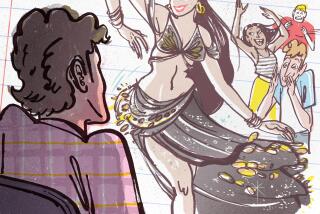A Dance to Our Micro-Selves
- Share via
Cartoonist Jules Feiffer occasionally draws a near-anorexic, often depressed, but nonetheless resilient ballerina who proposes a dance to this subject or that. Sometimes she ends with a pirouette of joy, sometimes she slumps to the floor in a posture of abject defeat.
With a bow to Feiffer, and more than a genuflection to Whitman, I propose a dance to spring, to the season of life’s renewal, that is also a dance to ourselves.
I don’t mean our macro-selves, the meat-puppets who slam-dance their way through the urban landscape, sometimes clad in two-ton chunks of armor, sometimes wrapped only in the callus of indifference, the protective carapace we wear to distance ourselves from each other and our fears.
I propose instead a dance to our micro-selves, a dance to our dance. For we are a dance. Every one of our cells is a living, pulsating, undulating protoplasmic Nijinsky. Some of our cells thump to the steady beat of rap, some glide to a pavane, some measure their lives in the complex percussions of the gamelan. Some dance together as organs, others dance alone.
I propose a dance to spring on a cellular level, and, to begin, I’d like to sashay across the floor and tap on the shoulder of a phytoplankton, our one-celled cousins who boogie in profusion just offshore, in Santa Monica Bay and Long Beach Harbor and in the great oceans beyond. Because the concentration of salts in both seawater and blood are almost identical, and because, millennia ago, our unicellular ancestors were themselves born of the sea, any dance to the phytoplankton is, in truth, a dance to ourselves.
I celebrate their importance: Through a process that can only be called magic--and so much of “science” is just inventing names for the magic--they engage in photosynthesis, turning sunlight into food and oxygen far more successfully than the ancient alchemists’ lofty promises of gold from base metals.
I celebrate their gifts: Oxygen, for one--somewhere between 40% and 60% of the oxygen we breathe comes not from the forests on land, but from the forests of phytoplankton in the sea. Food, for another--they are the bottom of the aquatic food chain, prey for the organisms next in size, etcetera, etcetera, until the life they wrest from sunlight metamorphoses into the flesh of the sea creatures and plants that feed us.
I celebrate their delicacy: The marvelous process of photosynthesis that is their gift can take place only in the first 33 feet of offshore water, give or take a foot. Sunlight cannot penetrate below that level, nor can photosynthesis take place in turbid water, or too-cold-water, or too-warm or too-salty water.
I celebrate their resilience: They flourish in the face of the continuous assault of our urban runoff--that’s the bureaucratic name for the tens of millions of gallons of excess lawn and car-wash water that daily conveys every manner of toxic pesticides, detergents, automotive fluids, pet waste, polystyrene and just plain trash from our streets into storm drains and, untreated, into the phytoplanktons’ living room.
They survive our “treated” human waste, which we delicately call “solids,” that can overenrich their aquatic environment and cause them to bloom magnificently, then die of oxygen depletion, gone like a supernova consuming itself. And they survive the chlorine we dump in to purify our solids.
They survive our fires and our floods, our development practices that denude hillsides and wash tons of topsoil into the water, often making it too cloudy for photosynthesis.
I celebrate their survival and, as I bow to my phytoplankton partner in thanks for this moment of terpsichorean bliss, I bow as well in a short prayer that we humans--prideful agglomerations of bacteria that we are--have not gone so far as to irreparably damage the gracile web of life that cradles us all in its strands.
If you’d care to join me, find a quiet spot, sit and listen. Hear the throb of blood in your ears, the slow, steady, reassuring rhythm of the tough muscle cells of your heart at work, propelling the rich blood cells that carry the nourishing oxygen that began in the sea. Compare that rhythmic sound to the tidal cadence of ocean waves, and imagine the phytoplankton hard at work just underneath.
Call it a dance, to spring.
More to Read
The biggest entertainment stories
Get our big stories about Hollywood, film, television, music, arts, culture and more right in your inbox as soon as they publish.
You may occasionally receive promotional content from the Los Angeles Times.










